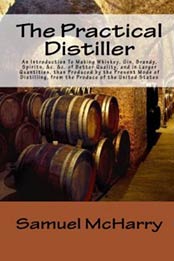
- Title:The Practical Distiller An Introduction To Making Whiskey, Gin, Brandy, Spirits, &c. &c. of Better Quality, and in Larger Quantities, than Produced by … from the Produce of the United States
- Autor: Samuel McHarry
- Pages: 92
- Publisher (Publication Date): CreateSpace Independent Publishing Platform (January 12, 2010)
- Language: English
- ISBN-10: 1450529496
- Download File Format: EPUB
“The Practical Distiller,” first published in 1809 when spirit distillation legal in the United States, describes the methods for making whiskey and other forms of liquor from the 1600’s onward. “The Practical Distiller” has some unique stories about some of the old distilleries, and explains many things that were no doubt helpful to the brewers of that day. Section one discussed yeast, how to know when it is good or bad, how to renew it when it is sour, and the best yeast for daily use. A second section deals with hogsheads and how to sweeten them by scalding or burning. The third section covers how to mash and distill rye or corn, how to know when grain is scalded enough, and how to prevent hogsheads from “working over.” Section four covers choosing the best rye and malt, how to grind Indian corn, hops, and building a malt kiln. Section five talks about singling, stalement, and distilling of different crops including buckwheat, potatoes, pumpions, peaches, turnips, and apples. Section six addresses the best methods of setting stills and preventing cracking, doubling stills, and heating more than one still with one fire or furnace. Section seven covers how to clarify whiskey and making Rye Whiskey, Apple Brandy, a Jamaica Spirit, Holland Gin, and country gin. It also discusses fining and coloring liquors, as well as a way to correct the taste of singed whiskey and gave an aged flavor to whiskey. The succeeding sections of “The Practical Distiller”discuss weather, ways to prevent a fire in the distillery, duties of hired distillers, and profitability for the owner. The book ends with a number of general “recipes” on how to make honey wine, elderberry wine, “and excellent American wine.”. While “The Practical Distiller” is primarily a historical book, it is fascinating to hear how things used to be done, and also tempting to wish that potatoes could still be bought for thirty-three cents a bushel as they could when this book was published!
![Craft Distilling: Making Liquor Legally at Home by Victoria Redhed Miller [0865718040, Format: EPUB] 0865718040](https://cookebooks.info/wp-content/uploads/2019/01/0865718040.jpg)
![The Joy of Home Distilling: The Ultimate Guide to Making Your Own Vodka, Whiskey, Rum, Brandy, Moonshine, and More by Rick Morris [1629145866, Format: PDF] 1629145866](https://cookebooks.info/wp-content/uploads/2018/12/1629145866.jpg)
![Home Distillation by Lionel Stephens [EPUB: 9798566480350] Home Distillation by Lionel Stephens](https://cookebooks.info/wp-content/uploads/2020/12/9798566480350-2.jpg)
![Moonshine Nation by Mark Spivak [0762797029, Format: PDF] 0762797029](https://cookebooks.info/wp-content/uploads/2019/06/0762797029.jpg)
![The Terroir of Whiskey by Rob Arnold [EPUB: 0231194587] The Terroir of Whiskey by Rob Arnold](https://cookebooks.info/wp-content/uploads/2021/01/0231194587-2.jpg)
![The United States of Cocktails by Brian Bartels [PDF: 1419742876] The United States of Cocktails by Brian Bartels](https://cookebooks.info/wp-content/uploads/2020/09/1419742876.jpg)